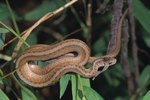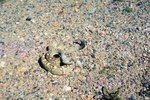
Among the many myths associated with snakes, one asserts that hibernating snakes produce a strong odor. In actuality, most credible sources discount such an association -- under normal circumstances, most humans find that snakes have no odor. Save for a few special circumstances, human noses do not detect smells in snake dens, either. However, some snakes find hibernacula by tracking conspecifics with their forked tongues and vomeronasal sense.
General Snake Smell
Clean snakes have very little -- if any -- odor. Lacking hair, feathers or dander, and shedding their skin in a punctuated, periodic manner, snakes do not produce smelly detritus like mammals and birds do. However, spending their lives crawling on their bellies, snakes occasionally crawl through foul-smelling substances. In the wild, snakes crawl through mud, dirt and decomposing leaf litter, while captives kept in unclean cages may crawl through feces or moldy substrates -- any of which may cause them to smell unpleasant.
Predator Repellent
Every living snake species is equipped with two pouchlike glands located in the base of their tails. Inside these glands, snakes store a foul-smelling liquid called musk. When threatened by a predator, snakes discharge the musk, often repelling the attackers. Some species coat themselves in musk as part of a defensive display, while others are capable of discharging the musk with great force, sometimes spraying it for a distance of several feet. Often, snakes void their intestines or vomit in conjunction with expelling musk, creating an even more offensive odor.
Rattlesnakes and Cucumbers
A pervasive myth suggests that rattlesnake dens smell like cucumbers. In his 1997 book “Rattlesnakes: Their Habits, Life Histories and Influence on Mankind, Volume 1,” herpetologist Laurence Monroe Klauber said a number of smells are associated with rattlesnake dens. Many people describe the dens and snakes as smelling like cucumbers; others describe the scent as skunklike, while some argue that the dens smell like decay. Klauber himself suggests that rattlesnake musk is not particularly pungent and he does not believe humans can smell dens from afar. He suggests that the occasional coincidence of a snake den and an odor is likely due to snakes who have died during hibernation or the rare snake who has a reason to discharge musk in the den.
A Trail of Breadcrumbs
While it is highly unlikely that a human could find a snake den or hibernacula by smell, this is exactly how some young rattlesnakes find their way to dens during their first winter. Timber rattlesnakes range far into the northern eastern United States; in places with such cold winters, the snakes must travel far under the ground to avoid freezing to death during the winter. This means that suitable dens are rare and usually inhabited by many snakes. In these cases, the adult rattlesnakes deposit pheromones while traveling to and from the dens. In the fall, the first-year young can detect these by using their forked tongues and vomeronasal systems.
References
- The Anatomical Record: Comparative Morphology of the Cloacal Scent Gland in Snakes (Serpentes: Reptilia)
- Herpetologica: Conspecific Scent-Trailing by Newborn Timber Rattlesnakes, Crotalus Horridus
- Rattlesnakes: Their Habits, Life Histories, and Influence on Mankind, Volume 1; Laurence Monroe Klauber
- Snakes of the Southeast; J. Whitfield Gibbons and Michael E. Dorcas
- CaliforniaHerps.com: Snake Behavior -- Defensive Strategies
Photo Credits
-
Jupiterimages/Photos.com/Getty Images



